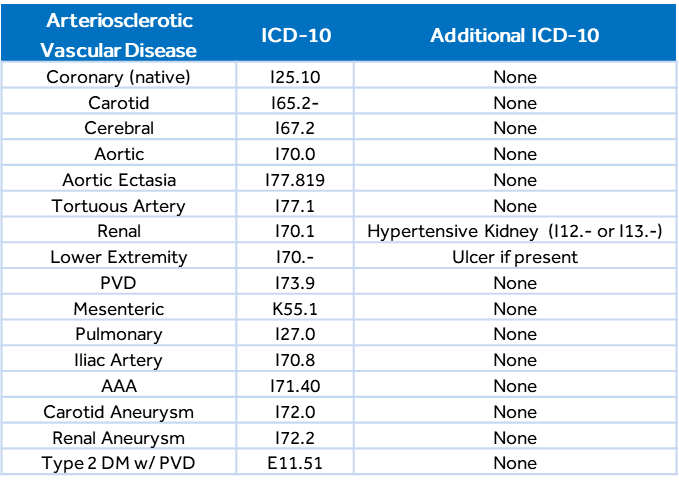
Vascular disease is a category of conditions that affect blood flow through arteries and veins. The cause of vascular disease can include the buildup of plaque in the arteries (atherosclerosis), blockage in the blood vessel by a mass of debris (embolus) or blood clot (thrombus), inflammation (vasculitis), and trauma or injury.
Chronic comorbid conditions can increase the risk of developing vascular disease and require risk management. These conditions generally include diabetes, high blood
pressure, heart attack or stroke, lack of physical activity, obesity, smoking, stress, and high levels of lipids.
Several Types of Vascular Disease:
- Arteriosclerosis
- Aneurysm
- Chronic Venous Insufficiency
- Intermittent Claudication
- Peripheral Vascular Disease (PVD)
- Deep Vein Thrombosis
- Pulmonary Embolism
- Varicose Veins
Despite the vastness of the vascular system, not all vascular diseases have an HCC value. Arteries of the heart, neck, and head are not HCC unless an acute infarction or angina is present.
Arterial disease can often be an incidental finding on radiology reports, usually found in the “findings” rather than the “impression of the report.” Managing the risk factors for arterial disease can improve patient outcomes and prevent complications.
Carotid artery disease occurs when fatty deposits (plaques) clog the blood vessels that deliver blood to the brain and head. This condition often is coded wrong because documentation does not specify plaque, atherosclerosis, stenosis, and/or occlusion. T correct ICD-10 assignment for Carotid Artery Stenosis is I65.2-.
Documentation & Coding
Vascular disease is a progressive disease. Therefore, avoid documenting a “history of vascular disease” and instead consider “known peripheral arterial disease” and specify atherosclerosis and location, if known.
Document Specificity
- Underlying Cause
- Artery & Location
- Ulcer Stage
- Gangrene & Amputation Status
ICD-10-CM presumes a causal relationship between “diabetes” and “lower extremity arteriosclerosis and/or peripheral angiopathy.” These conditions should be coded as related even without provider documentation explicitly linking them unless documentation clearly states the conditions are unrelated.

RESOURCES: Stanford Health; ICD-10-CM Official Guidelines
About the Author


